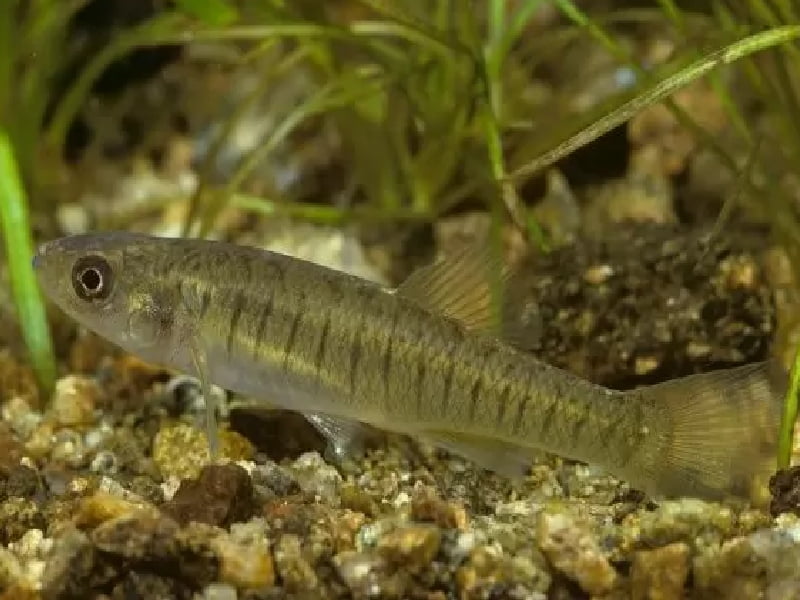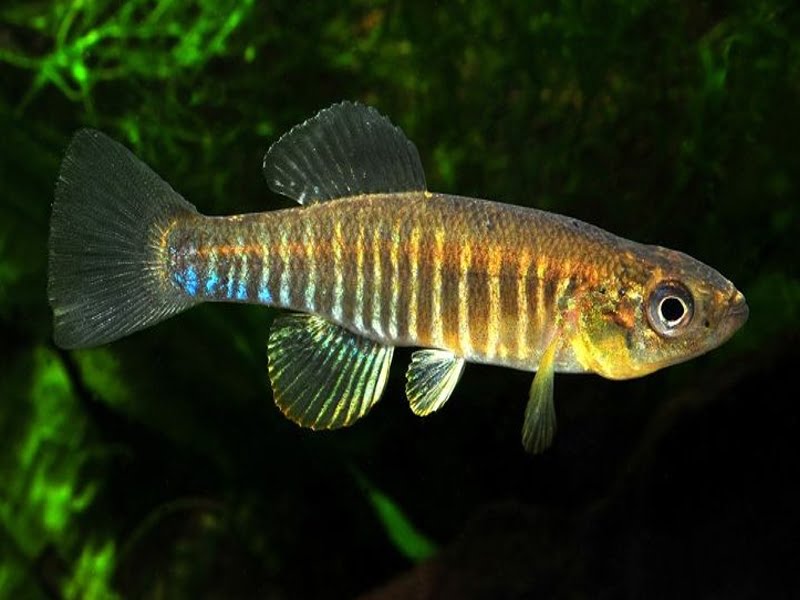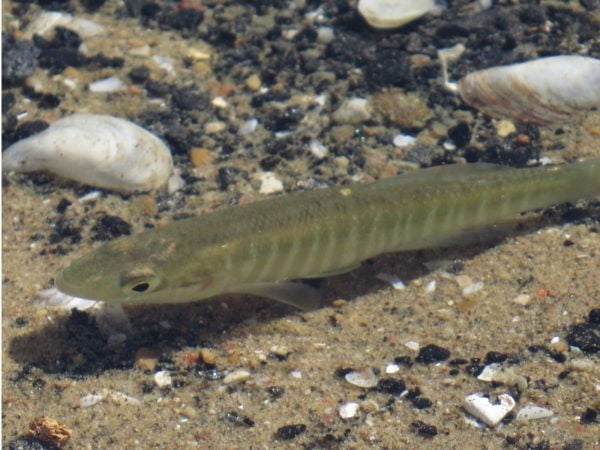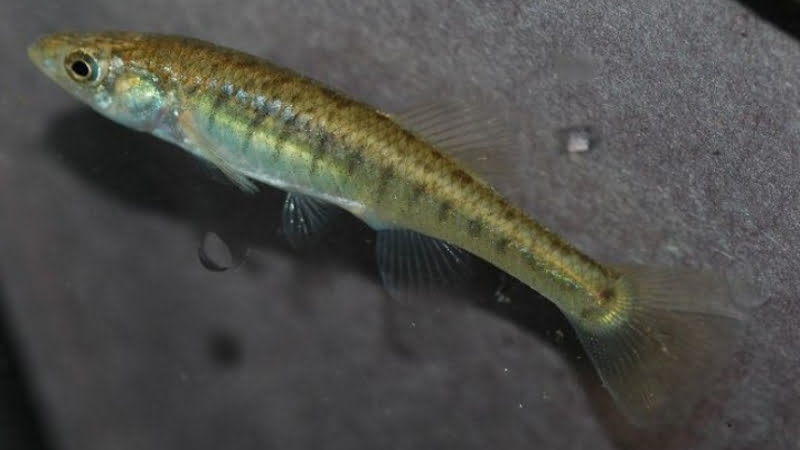An extremely temperate freshwater species of killifish, the western banded killifish (Fundulus diaphanous) is native to North America, the genus Fundulus of the family Fundulidae.
Throughout its natural geographical range, it is found everywhere from Newfoundland to South Carolina, and westward all the way to Minnesota, including in the Great Lakes drainage basins.
There is only one species of killifish that can be found in the northeastern states of this country, and that is freshwater killifish.
However, the fish will occasionally find itself in brackish water even though it is primarily a freshwater species.
The Origin Of The Name “Western Banded Killifish”
Commonly known as the “banded killifish”, the name is derived from the vertical black and white bands found on its sides which give it its distinctive appearance.
It is worth noting that the Latin genus name Fundulus is derived from the Greek name diaphanous which means “transparent” and the specific name Fundulus is derived from the Latin fundus.
Features Of The “Western Banded Killifish”
In contrast to the darker coloration on the ventral surface of the killifish, the dorsal surface of the banded killifish is olive-coloured.
As one might expect, the fins and throat are gold in colour. On both sides, there are contrasting stripes of blackish and silvery-white.
Banded killifishes have 13–15 rays on their dorsal fins, 10–12 on their anal fins, and 12–14 on their ventral fins. There is a slight convexity or roundness to the homocercal tail.
In addition, the homocercal tail is accompanied by a small pelvic fin. With flattish sides and a flattened head, its body is slender and elongated, and it has a small terminal mouth for surface feeding, as well as a rounded tail.
Approximately a third of the upper and lower jaws of banded killifishes are lined with large, sharp teeth.
On the side of the shell, the lateral series does not have a lateral line, instead, it is composed of 39 to 43 cycloid scales.
There are several sizes of banded killifish in the wild, ranging in length between 10 cm and 13 cm and weighing a few grams on average.
There are more female banded killifish than males, with females being larger in size.
Additionally, the sides of the females have darker bands. Males, on the other hand, possess pale gray bands that are arranged closely together.
A banded killifish’s dorsal fin can be used to determine the gender of a particular individual based on its number of bands.
Geographical Location And Distribution Range

There are a variety of locations in eastern North America where you can find the banded killifish, which range from as far south as South Carolina and as far north as the Atlantic provinces.
They are also found throughout the northern and eastern parts of Montana, as well as in the southern and northern parts of Ontario and Michigan.
One of the best habitats is found in the southern and northern areas of the Great Lakes.
The Committee on the Status of Endangered Wildlife in Canada (COSEWIC) has assigned banded killifish species status of special concern due to their biogeographic isolation and the potential limitations of their range expansion.
A killifish’s coloration is determined by its subspecies. The eastern banded killifish Fundulus diaphanous and the western banded killifish Fundulus diaphanous menona have different colorations.
In Ohio, the former is considered an invasive aquatic plant species that is considered to be an injurious aquatic plant.
There have been reports of intergrading between the Saint Lawrence River and Lake Erie. There is a substantial difference between the eastern and western subspecies.
Ecological Aspects Of Habitat
The average age of an adult is between 2 and 3 years old. In terms of their schooling ability, banded killifish are usually found in a group of 3 to 6 individuals, whereas the juveniles tend to travel in groups of 8 to 12.
There are many types of fish in lakes, ponds, rivers, estuaries, and wetlands with sandy, gravelly, muddy, and vegetated bottoms and abundant aquatic vegetation.
Typically, they tend to be found in shallow, calm areas with little or no disturbance.
There are many types of sand and gravel habitats around the reservoir, which provide hatchlings and juveniles with places to hide when threatened by predatory fish like largemouth bass Micropterus salmoides, northern pike Esox lucius, bluegill Lepomis macrochirus, and trout.
This is due to the fact that the banded killifish is relatively small, and the smaller size makes it not likely to venture into deeper waters, where it would be more at risk of predation and in a situation with fast currents, it may become unable to survive.
Nevertheless, we have observed that adult banded killifish will travel into deep water bodies to feed in order to survive. In order to protect themselves and their breeding grounds, banded killifish frequently congregate near aquatic vegetation, which also provides shelter.
Unlike their freshwater cousins, banded killifish occur in streams and lakes in freshwater habitats, but they are euryhaline fish.
In Indian Bay, in Canada, this species was observed to grow to be as tall as 12.8, the largest recorded size. Traditionally, this species is used as bait for commercial fisheries.
As a result, they are not favored by most people as pets. That is because they need a high level of maintenance, so they will not survive well in an aquarium.
A significant role of these organisms in aquatic ecosystems is that they provide food for larger fishes like largemouth bass, northern pike, and trout. Additionally to their use as food sources for birds, they are also utilized by other species such as belted kingfishers (Megaceryle alcyon), common mergansers (Mergus merganser), and herons.
According to the Newfoundland and Labrador Endangered Species Act and the Canada Species at Risk Act (SARA), the banded killifish was listed as one of Canada’s vulnerable species in January 2005.
A combination of industrial development, the use of motorized watercraft and the removal of aquatic vegetation have led to a decline in this species’ habitat.
Consumption
There has been evidence to suggest that banded killifish feed at all levels of the water column, not just at the surface.
Despite being so small, the species of this species feeds on a wide variety of things including insects, young nymphs, mollusks, turbellarians, and other small crustaceans.
The larvae of mosquitoes are also a common source of food for mosquitoes.
The smaller individuals, on the other hand, tend to eat fewer items and are more restricted to chironomid larvae, cladocerans, copepods, and midge larvae.
Young and adult banded killifish seem to feed almost exclusively in the afternoon, while younger offspring feed mostly in the morning.
Evolution Of Life And Reproduction
Killifish practice external fertilization where the female lays eggs and these eggs are equipped with adhesive threads that are able to adhere to the plants that the female is digging into.
Banded killifish may spawn in dense aquatic vegetation because they practice external fertilization. This may take place from June to mid-August depending upon the depth of the lake.
A phase of color change is experienced by the males of the species during the breeding season. At the base of their anal fin, the males display a bright blue patch.
Also, as the resulting body becomes bright blue on the lower portion, the colour of the rest of the body becomes dark blue.
In water temperatures between 21 and 23 degrees Celsius, the process of spawning takes place. As soon as the male has chosen a site in the shallow area of the water, he takes care to protect it from the other males.

It should be noted that the male will court a female and fight with the other males from the group, once a female appears. While the male pursues the female, she will give birth to one egg.
As soon as they are together, the female exudes 10 eggs into the water that are dropped on the bottom or get stuck to aquatic plants in the spawn area. Until the female has laid between 50 and 100 eggs, the male will continue to pursue the female.
There are several clutches of eggs that can be laid by a single female at the same time during the summer season.
The eggs are fertilized by both of the parents at the same time, and so after fertilization, the parents will move on to their separate businesses. There is no parental care provided for the eggs.
The average fry size is 6-7 millimeters and it emerges from the water within 10 to 12 days depending on the temperature of the water. A healthy fish can reach maturity at an average age of around a year and a half, reaching a maximum size of 6 centimeters.
A banded killifish can live more than two years in the water, depending on the conditions. On the other hand, there have been some, of who have lived longer than three years.
Assertion Of Behavior
Shoaling behavior
Banded killifish form shoals in groups of three or more. Shoaling occurs based on several factors, such as the type of water the shoal is located in, the species of fish that make up the shoal, and even the size of the shoal.
A cost and benefit analysis can be used to understand the phenomenon of shoaling. Food availability and predatory risk play a large role in determining the costs and benefits of a group membership.
As group sizes increase, predator protection remains relatively superior, but foraging becomes less of an advantage, as food will be distributed amongst the entire group instead of being highly concentrated.
There isn’t as much predator protection for small groups, but individual foraging opportunities are greater as each individual has more access to food than the other.
Banded killifish are influenced by their nutritional state when deciding whether or not they will form shoals. There is overwhelming evidence that those who lacked food spent more time alone and not in groups.
There has been no evidence to suggest that food-deprived individuals have smaller shoals than those of banded killifish that are fed frequently.
Generally, a well-fed killifish will stay with the shoal much longer than a hungry one. It is thus important to note that when a food stimulus is present, group size decreases so that individuals are not in competition with each other for access to these resources.
Food odours caused individuals to form looser shoals when surrounded by neighbours, but predatory stimulus on the other hand increased their attraction to neighbours and led to the formation of tighter groups. If one stimuli is present along with the other, the group size is intermediate.
Banded killifish are less likely to maintain their feeding posture and attempt food attempts in the presence of a predatory stimulus.
To avoid predatory vigilance and avoidance, it is important to devote more energy to predatory vigilance. Banded killifish feeding rates for individuals in the presence or absence of predatory stimuli are independent of the size of the shoal, regardless of the presence or absence of predators.
It is more expensive to be an individual because they do not benefit from the increased predatory protection afforded by continuous shoaling, and thus they tend to leave smaller shoals in favor of joining larger shoaling groups.
As a result of the predatory protection provided by shoals of banded killifish, they are more likely to join a shoal than to join a foraging group.

Anti-predator measures
There is an increased shoal size that increases when a predatory stimuli is present, allowing for greater protection via dilution.
A group of individuals is less likely to be attacked by a predator because of the dilution effect because there are many other individuals present in the group.
An individual of interest has a higher chance of being attacked by a predator in a larger group than there is of being attacked by someone from the other group.
In spite of the increased mortality risk, individuals straying from their shoal are at greater risk. This results in an increased tendency to the group.
Additionally to the fact that shoaling is a dilution effect, there are also benefits to the individual, such as group scrutiny.
Banded killifish need to be alert to detect potential predators so they can best protect themselves from attacks.
When members of a shoal are working together as a team, each individual can spend less time watching out for predators because these responsibilities can be shared by their comrades.
Each individual spends less and less time being vigilant as the shoal size increases, however, with more individuals, the group’s vigilance increases more as a whole, which benefits every individual in the shoal.
A shoal is alerted when an individual detects a predator by making an alarm call, which alerts the others of the shoal of the predator’s approach, and so they can defend themselves using defensive mechanisms.
The banded killifish often take refuge in refugee areas if they want to avoid predators. When faced with the threat of predators, fish will conceal themselves in a foodless shelter in order to survive.
Body size plays a key part in determining this preference. Generally, the size of the individual determines how much time they spend in the refuge as opposed to their smaller conspecifics.
There are more chances of individuals smaller than their larger counterparts getting stung by a banded killifish.
Video About The Western Banded Killifish
FAQs
What is the reason for the extinction of the western banded killifish?
During the past decade, the banded killifish has been assigned a designation of special concern by the Committee on the Status of Endangered Wildlife in Canada (COSEWIC), mainly due to biogeographic isolation and the restrictive potential of its range.
What is the life expectancy of a banded killifish?
The life expectancy of a killifish in an aquarium is between two and five years.
In terms of the killifish, one of the most intriguing things about them is their different spawning methods, which cause them to be divided into three basic groups: annuals, semi-annuals, and non-annuals.
There are 6 months periods of time during which annuals live in temporary pools that dry up each year for up to 6 months.
What is the nutritional value of killifish?
It is a non-poisonous fish, which means that humans are also able to consume it.
The fish is neither a very well-known nor widely consumed type of seafood.
A large part of its usage is as a pet fish, as bait to catch other larger fish, and as a research tool.

Annette M. Chaney is an experienced marine biologist with over 20 years of experience as an aquarist and fishkeeper. She started her first aquarium at a young age, filling it with frogs and goldfish obtained from the ten-cent pet store.
Annette grew up caring for and breeding African Cichlids, which led to a hobby in high school that doubled as a profitable means. Attending Reed College gave her time to solidify herself as an accomplished aquarium caretaker with an eye for sales. After that, from 2009 – 2013, she studied at Roger Williams University – one of the most prestigious universities for Aquaculture and Aquarium in USA. She is the founder of AquariumCircle since 2010.
